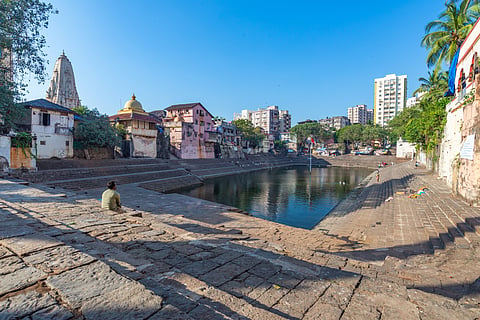City Finds: Did You Know About This Secret Water Tank In Mumbai?
Malabar Hills in south Mumbai is symbolic of the capital city of Maharashtra, with its Governor House, homes of rich people, towering buildings, leafy roads, swanky automobiles, and more. But tucked in a corner of this tony neighbourhood and a level or two below the main road is a strikingly different place, the Banganga Tank. The area is usually referred to as Walkeshwar, after the eponymous temple.
About Banganga Tank
Reached by a long stairway from the main road is the square-shaped lake hemmed by flights of wide steps. As you look down into the water, you find reflections of temples and humble residential quarters in the immediate neighbourhood merge into the reflections of towering buildings that etch the skyline above the image often broken into fissures by the flocks of swans swimming in the tank.
Like many pilgrim centres in India, the legend of the Banganga tank is linked with the epics, the Ramayana in this case. Of course the version of the story changes depending who you ask. According to the most popular version, brothers Ram and Lakshman were passing through the area in their bid to rescue Sita (who was kidnapped by the demon king Ravana of Lanka) when they felt thirsty. There was no source of sweet water owing to the nearness to the sea. Therefore, Lakshman (Ram according to some) shot an arrow into the ground. The Bhogavati Ganga, which is believed to flow underground, rose through the hole in the ground, and the brothers quenched their thirst. A pole stuck in the water is said to mark the spot.
About Walkeshwar Temple
There are several temples in the vicinity of the tank, the most popular being the Walkeshwar Temple. Ram is said to have built a Shivling from the sand and worshipped it here. Apparently known as Valuka Ishwar (the god made of sand), the name changed to Walkeshwar over time.
History
According to historical records, the tank and the temple was built in the 12th century by a minister in employment in the court of the Silhara rulers. However, the temple and its surroundings were likely destroyed by the Portuguese in the 16th century. In the 18th century, the destroyed complex was rebuilt by a Mumbai based businessman and philanthropist. As the place began to attract pilgrims, other temples too came up in the area along with pilgrim rest houses (dharamshalas).
Mini Benaras
With the tank and the temples around it, the flights of stairs or the ghats going down to the water, people coming to have a bath and offer prayers, the occasional funerary rituals being performed on the steps, have led many people to compare the place with Benaras (Varanasi).
The tank and its surroundings usually remain animated during the morning and evening. In between, you may find little children merrily taking a dip in the small ponds created in a corner of the larger tank, some religious institution holding a class in the open, or people just whiling away their time, sitting on the steps or feeding the swans.
Getting there
The neighbourhood usually goes by the name of Walkeshwar. You may take a local train to Charni Road (on the Western line) or take a bus to Teen Batti and take a local cab to Walkeshwar. Ask the local people for direction if you are not sure which lane to take. A flight of stairs will take you from the main road to the temple and tank complex. Sadly, the tank and its ghats may not always be spic and span.


